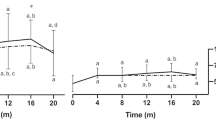Abstract
These procedures described for the dog ERG were approved at the 1st European Conference on Veterinary Visual Electrophysiology in Vienna, Austria, May 30, 2000. Dr. Narfström was Chair of the Committee for a Harmonized ERG Protocol, appointed by the European College of Veterinary Ophthalmology (ECVO), and Dr. Ofri was secretary. The other coauthors are committee members. Guidelines for ERG procedures in other animal species for clinical and laboratory studies are planned for in the future and the present guidelines are planned to be revised on a biannual basis. A brief report of the recommended procedures is available in the Conference Proceedings book.
Similar content being viewed by others
References
Gouras P. Electroretinography: Some basic principles. Invest Ophthalmol 1970; 9: 557–69.
Aguirre GD. Electroretinography in veterinary ophthalmology. J Am Anim Hosp Assoc 1973; 9: 234–7.
Acland GM. Diagnosis and differentiation of retinal diseases in small animals by electroretinography. Sem Vet Surg 1988; 3: 15–27.
Yanase J, Ogawa H, Ohtsuka, H. Rod and cone components in the dog electroretinogram during and after dark adaptation. J Vet Med Sci 1995; 57: 877–81.
Narfström K, Andersson B-E, Andreasson S, Gouras P. Clinical electroretinography in the dog using Ganzfeld stimulation: A practical method of examining rod and cone function. Doc Ophthalmol 1995; 90: 279–90.
Ofri R. Clinical electrophysiology in Veterinary Ophthalmology - The past, present and future. Doc Ophthalmol 2002; 104: 5–16.
Aguirre GD. Electroretinography - are we misusing an excellent diagnostic tool? Vet Comp Ophthalmol 1995; 5: 2–3.
Marmor MF, Zrenner E. Standard for clinical electroretinography (1999 update). Doc Ophthalmol 1999; 97: 143–56.
Brigell M, Bach M, Barber C, Kawasaki K, Kooijman A. Guidelines for calibration of stimulus and recording parameters used in visual clinical electroretinography. Doc Ophthalmol 1998; 95: 1–14.
Narfström K, Ekesten B. Diseases of the canine ocular fundus. In: Veterinary Ophthalmology 3rd edition. Lippincott Williams & Wilkins, Philadelphia, 1999, pp 887–908.
Jacobi PC, Miliczek K-D, Zrenner E. Experiences with the international standard for clinical electroretinography: Normative values for clinical practise, interindividual and intraindividual variations and possible extensions. Doc Ophthalmol 1993; 85: 95–114.
Author information
Authors and Affiliations
Rights and permissions
About this article
Cite this article
Narfström, K., Ekesten, B., Rosolen, S.G. et al. Guidelines for clinical electroretinography in the dog. Doc Ophthalmol 105, 83–92 (2002). https://doi.org/10.1023/A:1020524305726
Issue Date:
DOI: https://doi.org/10.1023/A:1020524305726




